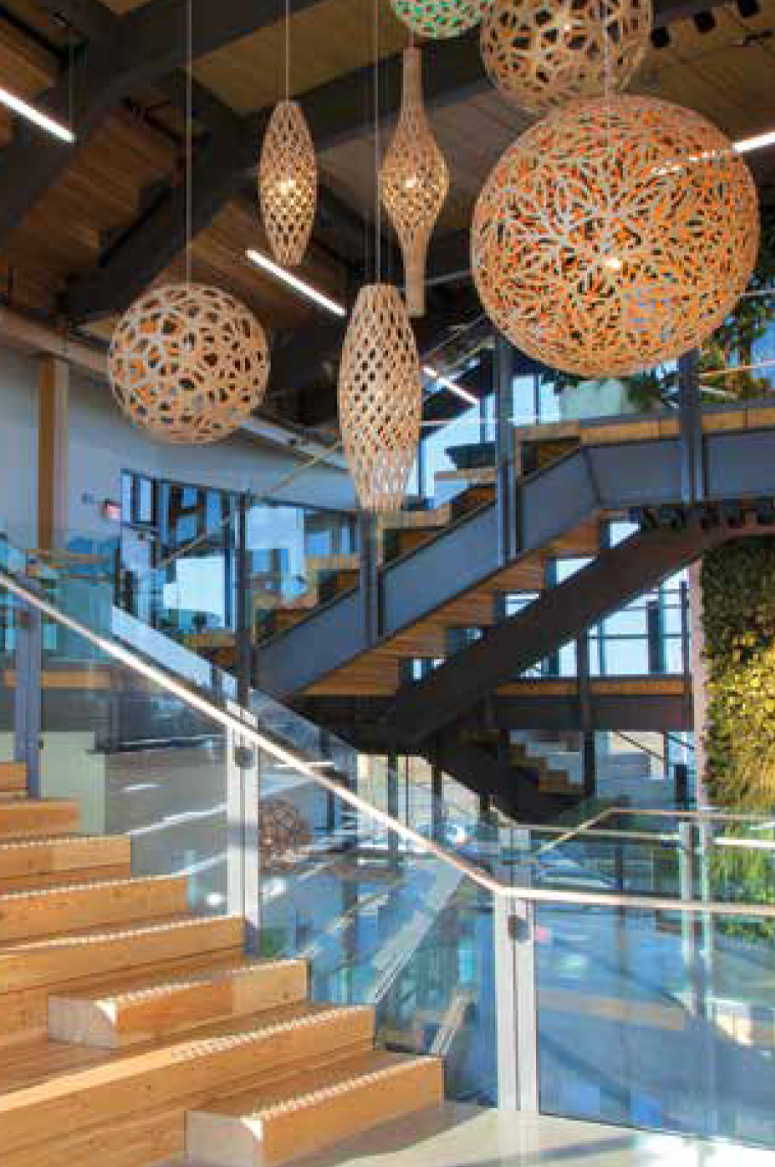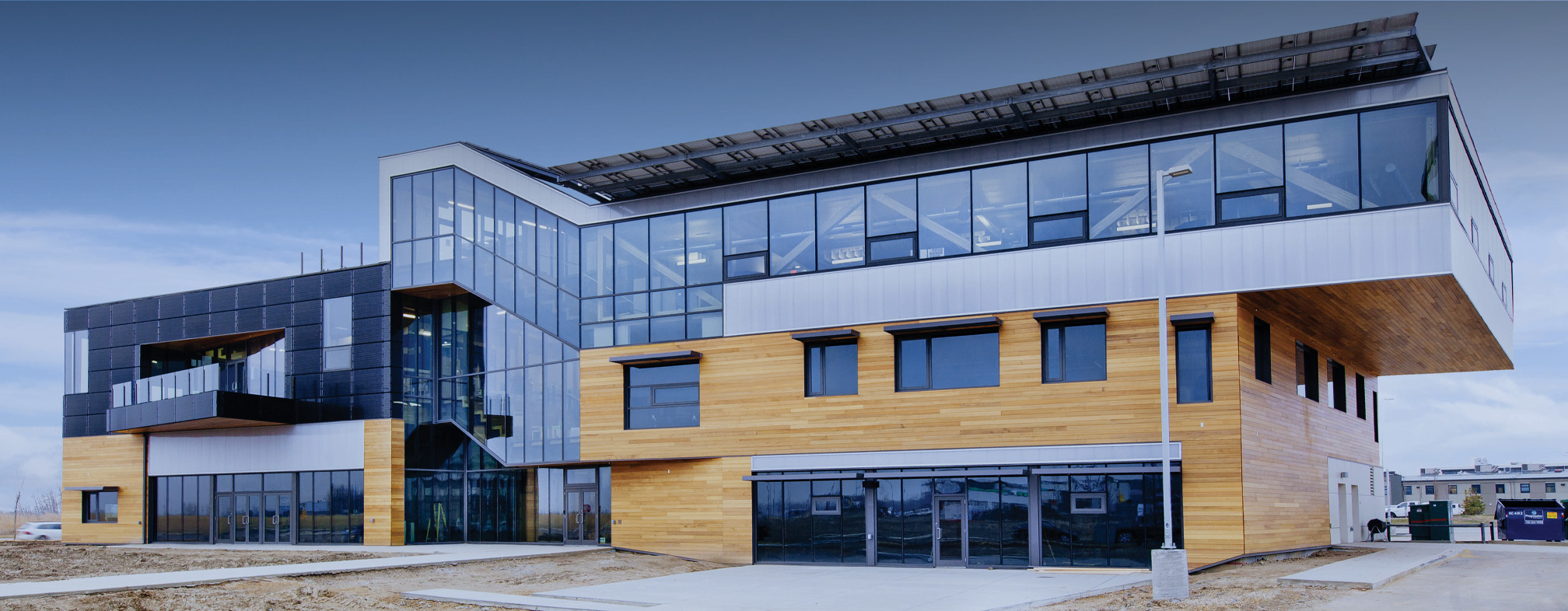Edmonton office goes for triple play of net zero, LEED Platinum and Living Building Challenge
 The Mosaic ‘Family’ comprises several employee-owned companies whose stated purpose is to create role model organizations that effect positive social change through business. In keeping with their philosophy, this 2,812m2 building provides the Mosaic Family not only with office space but employee amenities including a child-care facility, wellness centre, lounge areas, game rooms, a restaurant and an outdoor terrace.
The Mosaic ‘Family’ comprises several employee-owned companies whose stated purpose is to create role model organizations that effect positive social change through business. In keeping with their philosophy, this 2,812m2 building provides the Mosaic Family not only with office space but employee amenities including a child-care facility, wellness centre, lounge areas, game rooms, a restaurant and an outdoor terrace.
The building also functions as a community hub and as an incubator for start-up businesses. Even those who simply rent a desk in the building have access to meeting rooms as well as the other employee amenities, while the restaurant, wellness centre and childcare are is open to members of the surrounding community. The project is pursuing both LEED Platinum and Living Building certification. The net zero energy requirement of the Living Building Challenge is a particularly ambitious target given Edmonton’s severe climate. This, and the realization of other performance goals required an integrated design process involving all members of the design and construction team.
Site Context and Concept
The site is located at the edge of a commercial strip, part of a rapidly urbanizing area on the outskirts of the city. With net zero energy being a driver of design, optimal siting of the building was critical. The final location was determined by considering the overshadowing potential of different development scenarios on adjacent sites. In addition, rather than respecting the geometry of the city grid, the building has been oriented on an eastwest axis to maximize solar exposure through the day, This orientation, and the access to daylight it affords to south-facing spaces, also informed the interior organization of the building. Accordingly, the most densely occupied spaces are located on the periphery where they receive the most light.

The Mosaic centre in southeast edMonton. the building exterior has pV integration [1]. the light-filled atriuM connects the building's spaces. sun shades and high-perforMance windows help Keep the interior froM oVerheating [2]. the Mosaic centre borders a residential and coMMercial strip.
Bleacher seating incorporated in the Main atriuM stair proVides Meeting space. daVid trubridge light fixtures and a liVing wall feature proMinently in the atriuM [4]. sit-stand worKstations are created in a fully-daylit worK enVironMent in which oVerhead lighting is MiniMized [5]. building enVelope integrated photoVoltaic cladding panels help achieVe net zero energy
MateriaL
Fibreglass-frame curtain wall fitted with Fibrerglass Curtain Wall Vent Adaptor units and fibreglass windows by Cascadia Windows and Doors; building envelope integrated photovoltaic cladding panels; geoExchange tied to VRF water/air multi-split; tempeff RG5400 & RGSP 2700 energy recovery units.
Project Performance
Energy intensity [building and process energy] = 240 MJ/m2/year
Energy intensity reduction relative to reference building under ASHrAE 90.1 = 58%
Potable water consumption from municipal sources = 1,794 L/occupant/year
Potable water reduction relative to reference building = 36%
Reclaimed and recycled material content by value = 16%
Regional material [800km radius] content by value = 41%
Energy conservation
Strategies The optimal solar orientation also enabled the design team to minimize the building’s mechanical and electrical systems. In some areas it was determined that no general lighting was required, task lighting being sufficient to meet occupant needs even on the cloudiest days. Artificial lighting is therefore provided primarily in the path of egress, with motion and daylight sensors used to activate supplementary lighting only when it is needed. These strategies helped to reduce the annual electricity demand for the lighting system to 11.2 kwh/m2.
The Mosaic Centre’s mechanical system is divided into zones which focus on moving energy where it needs to be, instead of generating it for spaces that do not require it. Dynamic spaces that have significant fluctuations in occupancy have supplemental systems that are activated only when triggered by CO2 sensors. Together with a 213kW, 640 panel, rooftop mounted PV array and a 70m deep, 32 borehole geothermal field, these strategies enable the Mosaic Centre to liberate itself from Alberta’s coal-produced electricity supply, as the building produces more energy than it consumes. This even takes into account that some occupants power their electric cars using the building’s clean energy, which leverages geothermal and solar technologies.
The building itself has a high-performance envelope including an R-44 roof assembly and a fibreglass-based curtain wall system, with triple glazing and three low-e coatings. The solid portions of the wall have an R-value of 39. Air tightness and the control of vapour migration further reduce energy loss through the envelope.
Occupant Wellbeing
Access to daylight and fresh air is the foundation of a wellness strategy that includes the use of exposed wood, the specification of low-VOC finishes and the installation of a living wall, both as a biophilic element and as a purifier and humidifier of air. The Wellness Centre, bike racks and shower facilities, generous stairs and the specification of a slowmoving elevator all encourage physical activity throughout the day. The access to daylight and views, and the use of natural materials have also been proven to increase workplace performance. The fiberglass windows supplied by Cascadia are the only ones in the world that are Declared RED List Free through the Living Building Challenge program, meaning they contain no substantially toxic materials.
durability and life cycle
The Mosaic Centre is conceived, designed, constructed and operated as a high-performance sustainable building with inherent durability. A 50-year design service life was chosen for the Mosaic Centre which is the typical lifespan for office facilities. The predicted service life of most components equals or exceeds the Design Service Life of the building. The design and construction of the Mosaic Centre is the subject of a documentary, commissioned by the client in order to share the lessons learned with the broadest possible audience, and inspire others to emulate or surpass the achievements of this project.




 The Mosaic ‘Family’ comprises several employee-owned companies whose stated purpose is to create role model organizations that effect positive social change through business. In keeping with their philosophy, this 2,812m2 building provides the Mosaic Family not only with office space but employee amenities including a child-care facility, wellness centre, lounge areas, game rooms, a restaurant and an outdoor terrace.
The Mosaic ‘Family’ comprises several employee-owned companies whose stated purpose is to create role model organizations that effect positive social change through business. In keeping with their philosophy, this 2,812m2 building provides the Mosaic Family not only with office space but employee amenities including a child-care facility, wellness centre, lounge areas, game rooms, a restaurant and an outdoor terrace. 